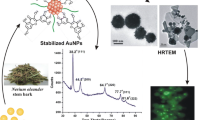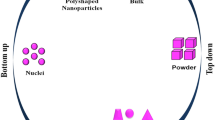Abstract
Gold nanoparticles (GNPs) are forecasted to provide an attractive platform in biomedicine and catalysis with their potentials of combining a variety of biophysicochemical properties into an integrated nanodevice with great therapeutic and optical functions. There are several reports of crude plant extracts mediating the conversion of metal ions into nanoparticles. However, we aimed to investigate the capability of single bioactive compounds, namely ginsenosides compound K (C-K) and Rh2, to accommodate a synergistic chemical reduction of gold salts by one-pot green chemistry. Ginsenosides C-K and Rh2 are unique triterpenoid saponins present in Panax ginseng Meyer, a perennial plant traditionally used as an oriental medicinal herbal with long history. C-K and Rh2 have demonstrated diverse pharmacological properties such as anticancer, anti-inflammation, anti-aging, and neuroprotective properties. The reduction of gold ions by these ginsenosides led to the production of nontoxic GNPs as tested in mouse macrophage (J774A.1) and human kidney epithelial (HEK-293) in vitro. The kinetics of the bioreduction and the influence of pH were examined by an ultraviolet-visible (UV-Vis) spectrophotometer. GNPs were characterized by field emission transmission electron microscopy (FE-TEM), X-ray diffraction (XRD), dynamic light scattering (DLS), and Fourier transform infrared (FTIR) spectroscopy. Ginsenoside loading efficiency of C-K-GNPs and Rh2-GNPs was determined to be approximately 62.83% and 54.91%, respectively, by thermogravimetric analysis (TGA). These results suggest that one-pot synthesis by ginsenosides C-K and Rh2 may be useful for producing ginsenoside-loaded gold nanocarriers.

Graphical abstract










Similar content being viewed by others
References
Abbai R et al (2016) Green synthesis of multifunctional silver and gold nanoparticles from the oriental herbal adaptogen: Siberian ginseng. Int J Nanomed 11:3131
Ahmad N, Sharma S, Alam MK, Singh V, Shamsi S, Mehta B, Fatma A (2010) Rapid synthesis of silver nanoparticles using dried medicinal plant of basil. Colloids and Surf B Biointerfaces 81:81–86
Ahn S, Singh P, Castro-Aceituno V, Yesmin Simu S, Kim Y-J, Mathiyalagan R, Yang D-C (2017) Gold nanoparticles synthesized using Panax ginseng leaves suppress inflammatory-mediators production via blockade of NF-κB activation in macrophages. Artif Cells, Nanomed Biotechnol 45:270–276
Christensen LP (2008) Ginsenosides: chemistry, biosynthesis, analysis, and potential health effects. Adv Food Nutr Res 55:1–99
Du G-J, Dai Q, Williams S, Wang C-Z, Yuan C-S (2011) Synthesis of protopanaxadiol derivatives and evaluation of their anticancer activities. Anticancer Drugs 22:35
Dwivedi AD, Gopal K (2010) Biosynthesis of silver and gold nanoparticles using Chenopodium album leaf extract. Colloids Surf A Physicochem Eng Asp 369:27–33
Eustis S, El-Sayed MA (2006) Why gold nanoparticles are more precious than pretty gold: noble metal surface plasmon resonance and its enhancement of the radiative and nonradiative properties of nanocrystals of different shapes. Chem Soc Rev 35:209–217
Fuzzati N (2004) Analysis methods of ginsenosides. J Chromatogr B 812:119–133
Iravani S (2011) Green synthesis of metal nanoparticles using plants. Green Chem 13:2638–2650
Ji X, Song X, Li J, Bai Y, Yang W, Peng X (2007) Size control of gold nanocrystals in citrate reduction: the third role of citrate. J Am Chem Soc 129:13939–13948
Jia L, Zhao Y (2009) Current evaluation of the millennium phytomedicine-ginseng (I): etymology, pharmacognosy, phytochemistry, market and regulations. Curr Med Chem 16:2475–2484
Joydeep D et al (2016) Efficient delivery of C/EBP beta gene into human mesenchymal stem cells via polyethylenimine-coated gold nanoparticles enhances adipogenic differentiation. Sci Rep 6:37480
Kasthuri J, Veerapandian S, Rajendiran N (2009) Biological synthesis of silver and gold nanoparticles using apiin as reducing agent. Colloids Surf B Biointerfaces 68:55–60
Klekotko M, Matczyszyn K, Siednienko J, Olesiak-Banska J, Pawlik K, Samoc M (2015) Bio-mediated synthesis, characterization and cytotoxicity of gold nanoparticles. Phys Chem Chem Phys 17:29014–29019
Lee SM, Bae B-S, Park H-W, Ahn N-G, Cho B-G, Cho Y-L, Kwak Y-S (2015) Characterization of Korean red ginseng (Panax ginseng Meyer): history, preparation method, and chemical composition. J Ginseng Res 39:384–391
Leonard K, Ahmmad B, Okamura H, Kurawaki J (2011) In situ green synthesis of biocompatible ginseng capped gold nanoparticles with remarkable stability. Colloids Surf B Biointerfaces 82:391–396
Li R, Dong W, He H, Yan H, Jiang X, Gong J (2012) Isolation, characterization and phase transformation of new ginsenoside compound k hydrate and methanol solvates. Cryst Res Technol 47:377–384
Li S, Gao Y, Ma W, Guo W, Zhou G, Cheng T, Liu Y (2014) EGFR signaling-dependent inhibition of glioblastoma growth by ginsenoside Rh2. Tumor Biol 35:5593–5598
Li S, Guo W, Gao Y, Liu Y (2015) Ginsenoside Rh2 inhibits growth of glioblastoma multiforme through mTor. Tumor Biol 36:2607–2612
Link S, El-Sayed MA (1999) Size and temperature dependence of the plasmon absorption of colloidal gold nanoparticles. J Phys Chem B 103:4212–4217
Makarov V, Love A, Sinitsyna O, Makarova S, Yaminsky I, Taliansky M, Kalinina N (2014) “Green” nanotechnologies: synthesis of metal nanoparticles using plants. Acta Naturae 6:35–44
Markus J et al (2016) Intracellular synthesis of gold nanoparticles with antioxidant activity by probiotic Lactobacillus kimchicus DCY51 T isolated from Korean kimchi. Enzyme Microb Technol 95:85–93
Markus J, Wang D, Kim Y-J, Ahn S, Mathiyalagan R, Wang C, Yang DC (2017) Biosynthesis, characterization, and bioactivities evaluation of silver and gold nanoparticles mediated by the roots of Chinese herbal Angelica pubescens. Maxim Nanoscale Res Lett 12:46
Mathiyalagan R, Subramaniyam S, Kim YJ, Kim Y-C, Yang DC (2014) Ginsenoside compound K-bearing glycol chitosan conjugates: synthesis, physicochemical characterization, and in vitro biological studies. Carbohydr Polym 112:359–366
Mittal AK, Chisti Y, Banerjee UC (2013) Synthesis of metallic nanoparticles using plant extracts. Biotechnol Adv 31:346–356
Mohamed MB, Volkov V, Link S, El-Sayed MA (2000) The ‘lightning’ gold nanorods: fluorescence enhancement of over a million compared to the gold metal. Chem Phys Lett 317:517–523
Mulvaney P (1996) Surface plasmon spectroscopy of nanosized metal particles. Langmuir 12:788–800
Noruzi M (2015) Biosynthesis of gold nanoparticles using plant extracts. Bioprocess Biosyst Eng 38:1–14
Sanna V et al (2014) Single-step green synthesis and characterization of gold-conjugated polyphenol nanoparticles with antioxidant and biological activities. Int J Nanomedicine 9:4935
Shankar SS, Ahmad A, Pasricha R, Sastry M (2003) Bioreduction of chloroaurate ions by geranium leaves and its endophytic fungus yields gold nanoparticles of different shapes. J Mater Chem 13:1822–1826
Shin B-K, Kwon SW, Park JH (2015) Chemical diversity of ginseng saponins from Panax ginseng. J Ginseng Res 39:287–298
Si S, Mandal TK (2007) Tryptophan-based peptides to synthesize gold and silver nanoparticles: a mechanistic and kinetic study. Chemistry–A European Journal 13:3160–3168
Singh AK, Talat M, Singh DP, Srivastava O (2010) Biosynthesis of gold and silver nanoparticles by natural precursor clove and their functionalization with amine group. J Nanopart Res 12:1667–1675
Singh DK, Jagannathan R, Khandelwal P, Abraham PM, Poddar P (2013) In situ synthesis and surface functionalization of gold nanoparticles with curcumin and their antioxidant properties: an experimental and density functional theory investigation. Nanoscale 5:1882–1893
Singh P, Kim Y-J, Zhang D, Yang D-C (2016) Biological synthesis of nanoparticles from plants and microorganisms. Trends Biotechnol 34:588–599
Singh P, Kim YJ, Wang C, Mathiyalagan R, Yang DC (2015) The development of a green approach for the biosynthesis of silver and gold nanoparticles by using Panax ginseng root extract, and their biological applications. Artif cells, Nanomed Biotechnol 44:1150–1157
Xue P, Yao Y, Yang X-s, Feng J, Ren G-x (2016) Improved antimicrobial effect of ginseng extract by heat transformation. J Ginseng Res. doi:10.1016/j.jgr.2016.03.002
Yang X-D, Yang Y-Y, Ouyang D-S, Yang G-P (2015) A review of biotransformation and pharmacology of ginsenoside compound K. Fitoterapia 100:208–220
Acknowledgements
This research was supported by the Next-Generation BioGreen 21 Program (SSAC, grant No. PJ0120342017), Rural Development Administration, Republic of Korea.
Author information
Authors and Affiliations
Corresponding authors
Ethics declarations
Conflict of interest
The authors declare that they have no competing interests.
Electronic supplementary material
Supplementary Figure 1
TLC analysis of ginsenosides C-K (a) and Rh2 (b) at different pH conditions after heat-treated. (GIF 284 kb)
Rights and permissions
About this article
Cite this article
Hurh, J., Markus, J., Kim, YJ. et al. Facile reduction and stabilization of ginsenoside-functionalized gold nanoparticles: optimization, characterization, and in vitro cytotoxicity studies. J Nanopart Res 19, 313 (2017). https://doi.org/10.1007/s11051-017-3980-x
Received:
Accepted:
Published:
DOI: https://doi.org/10.1007/s11051-017-3980-x




